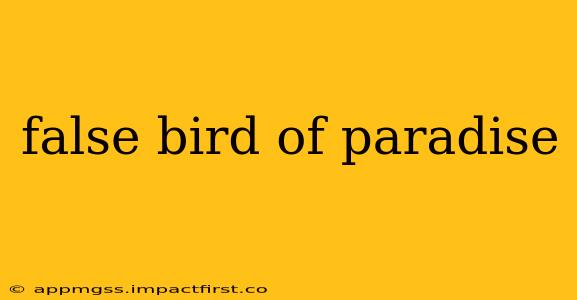The term "false bird of paradise" often evokes a sense of mystery. What exactly is it, and how does it differ from its more famous namesake? This comprehensive guide will delve into the captivating world of Strelitzia juncea, the plant commonly known as the false bird of paradise, exploring its unique characteristics, care requirements, and captivating allure.
What is a False Bird of Paradise?
The false bird of paradise (Strelitzia juncea) is a striking succulent-like plant belonging to the Strelitziaceae family, closely related to its more flamboyant cousin, the bird of paradise flower (Strelitzia reginae). Unlike the Strelitzia reginae, which boasts large, showy leaves, the Strelitzia juncea features slender, cylindrical leaves that resemble reeds or straws. These unique leaves, growing upright from a central crown, contribute significantly to its distinctive, almost architectural appearance. It's this striking difference that earns it the moniker "false" bird of paradise.
How Does it Differ from a Bird of Paradise Flower?
The key differences between the true bird of paradise (Strelitzia reginae) and its false counterpart (Strelitzia juncea) lie primarily in their foliage:
- Leaves: The Strelitzia reginae has large, paddle-shaped leaves, while the Strelitzia juncea has narrow, reed-like leaves. This is the most noticeable distinction.
- Size: While both can reach considerable heights, Strelitzia reginae tends to be broader and bushier, whereas Strelitzia juncea maintains a more upright and slender form.
- Maintenance: Strelitzia juncea is often considered slightly easier to care for, particularly in terms of space requirements, as its narrower form makes it suitable for smaller gardens or containers.
Both plants, however, share the vibrant, orange and blue bird-like flowers that give the family its common name.
What are the Care Requirements for a False Bird of Paradise?
While relatively low-maintenance, providing optimal care will ensure the flourishing of your Strelitzia juncea:
- Sunlight: These plants thrive in full sun to partial shade. At least six hours of sunlight per day is ideal, although some afternoon shade in particularly hot climates is beneficial.
- Watering: Water deeply but infrequently, allowing the soil to dry out completely between waterings. Overwatering can lead to root rot. During winter months, reduce watering significantly.
- Soil: Well-draining soil is crucial. A sandy loam mix is perfect.
- Temperature: Strelitzia juncea prefers warm temperatures, thriving in USDA hardiness zones 9-11. Protect from frost.
- Fertilizing: Fertilize sparingly, using a balanced liquid fertilizer during the growing season (spring and summer).
Does the False Bird of Paradise Produce Flowers?
Yes, the Strelitzia juncea does produce flowers, albeit often less frequently than the Strelitzia reginae. The flowers are similar in appearance, displaying the iconic orange and blue hues characteristic of the genus, resembling a bird's head.
Is the False Bird of Paradise Poisonous?
While not considered highly toxic, it's prudent to treat all parts of the Strelitzia juncea as potentially irritating. Keep away from children and pets. Contact with the sap may cause skin irritation in sensitive individuals.
Where Can I Buy a False Bird of Paradise?
False bird of paradise plants are readily available from various nurseries, garden centers, and online plant retailers. When purchasing, ensure the plant is healthy and free from pests or diseases. Look for vibrant, upright leaves and a well-established root system.
Conclusion: Embracing the Unique Beauty of Strelitzia juncea
The false bird of paradise offers a unique and elegant addition to any garden or indoor space. Its architectural form and striking foliage provide a captivating contrast to more traditional landscaping. By understanding its specific needs and appreciating its subtle differences from its more famous cousin, you can unlock the full potential of this intriguing and rewarding plant.
